University CSR Analysis: Narrow View Critique and ABC News Report
VerifiedAdded on 2022/09/28
|12
|3157
|31
Report
AI Summary
This report delves into the concept of Corporate Social Responsibility (CSR), examining its definition and importance for businesses to contribute positively to society. It outlines the narrow view of CSR, which emphasizes profit maximization and shareholder interests, and provides a detailed critique of this perspective. The report discusses the arguments in favor of the narrow view, such as the focus on efficiency and the role of managers, while also highlighting the criticisms, including the evolution of business environments and the increasing influence of public opinion. The report also analyzes an ABC News report on CSR activities, particularly in Australian banks, revealing issues of transparency and the prioritization of marketing over genuine social investment. It also discusses the agency and stakeholder theories, highlighting the importance of considering the interests of all stakeholders, not just shareholders, to ensure long-term organizational success.
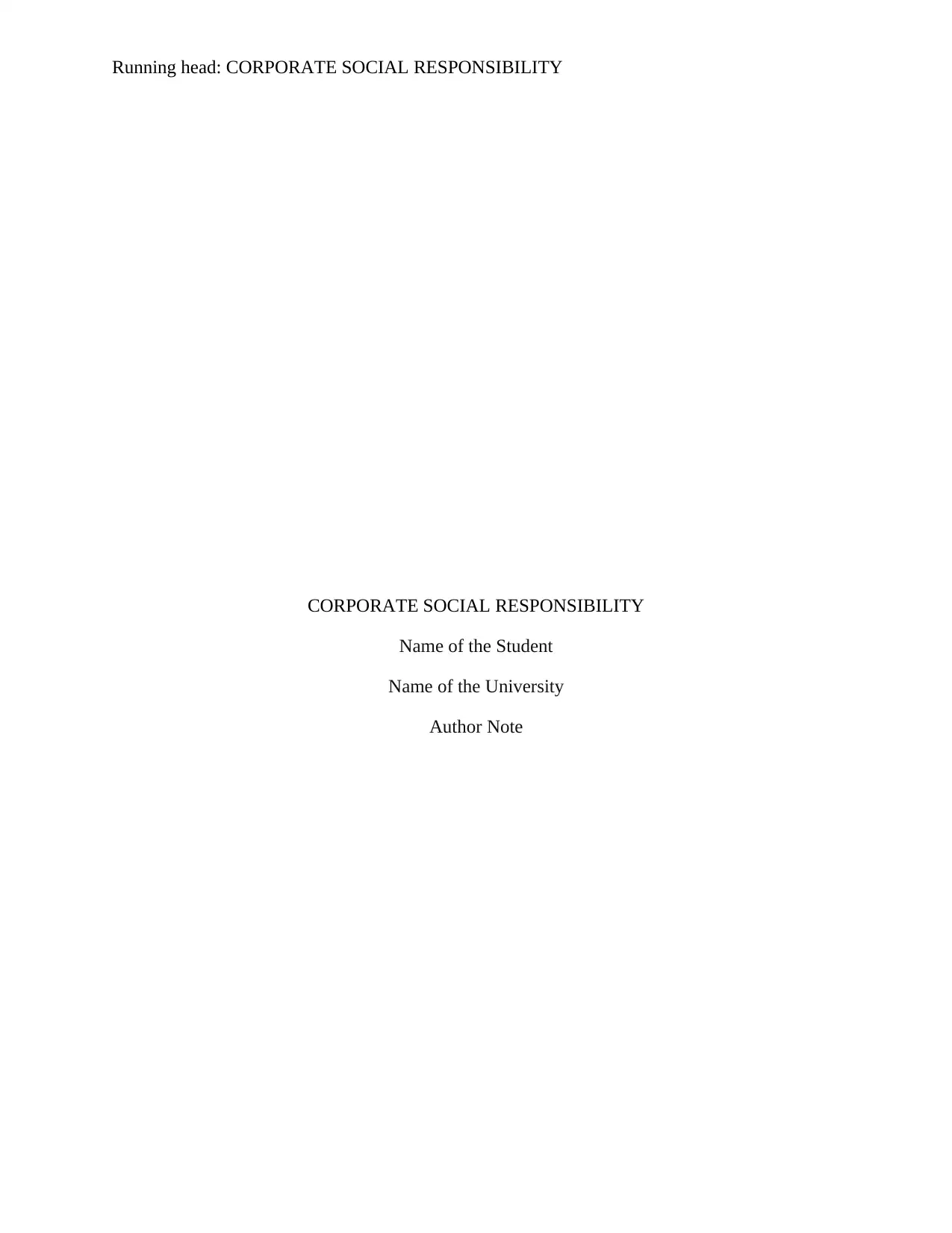
Running head: CORPORATE SOCIAL RESPONSIBILITY
CORPORATE SOCIAL RESPONSIBILITY
Name of the Student
Name of the University
Author Note
CORPORATE SOCIAL RESPONSIBILITY
Name of the Student
Name of the University
Author Note
Paraphrase This Document
Need a fresh take? Get an instant paraphrase of this document with our AI Paraphraser
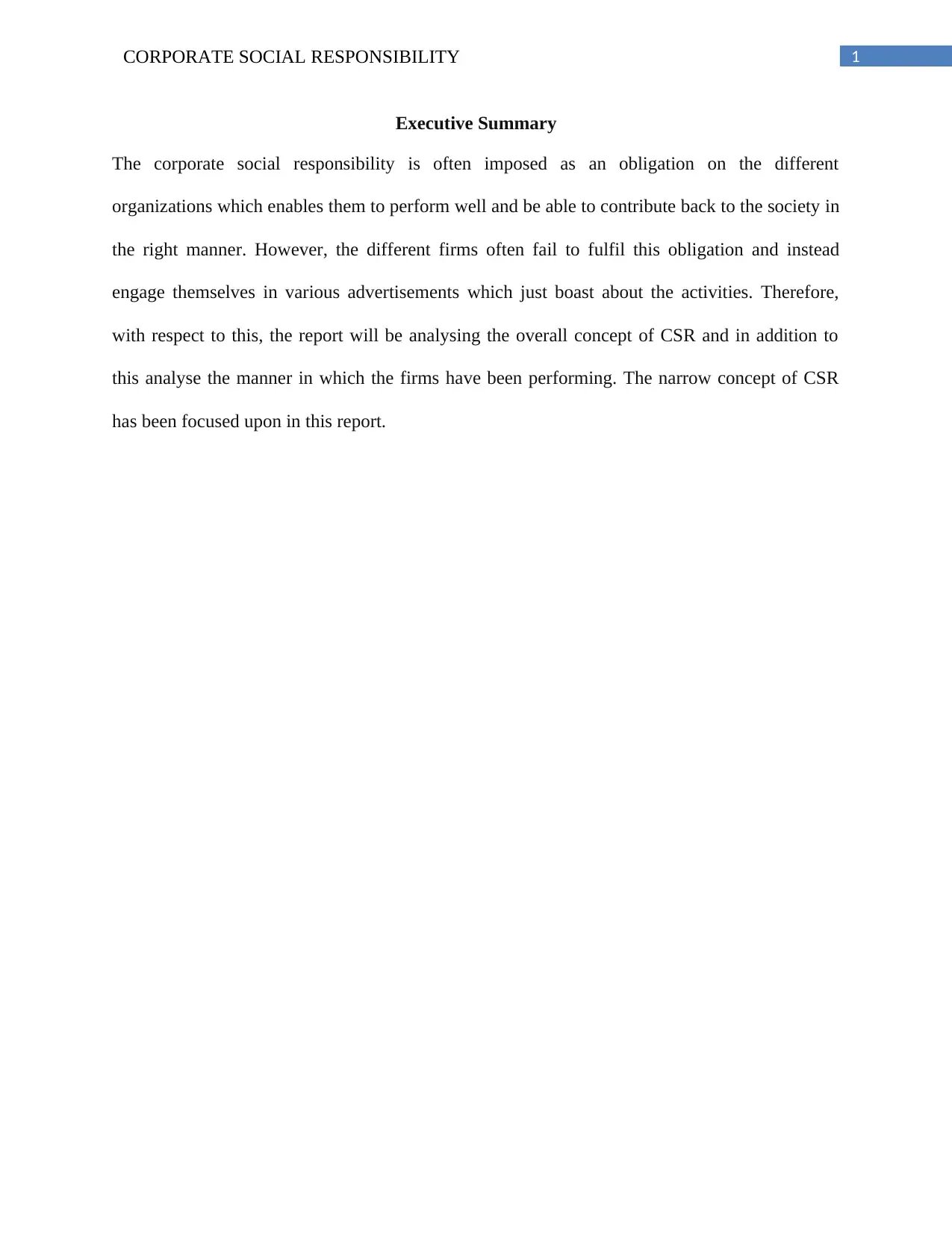
1CORPORATE SOCIAL RESPONSIBILITY
Executive Summary
The corporate social responsibility is often imposed as an obligation on the different
organizations which enables them to perform well and be able to contribute back to the society in
the right manner. However, the different firms often fail to fulfil this obligation and instead
engage themselves in various advertisements which just boast about the activities. Therefore,
with respect to this, the report will be analysing the overall concept of CSR and in addition to
this analyse the manner in which the firms have been performing. The narrow concept of CSR
has been focused upon in this report.
Executive Summary
The corporate social responsibility is often imposed as an obligation on the different
organizations which enables them to perform well and be able to contribute back to the society in
the right manner. However, the different firms often fail to fulfil this obligation and instead
engage themselves in various advertisements which just boast about the activities. Therefore,
with respect to this, the report will be analysing the overall concept of CSR and in addition to
this analyse the manner in which the firms have been performing. The narrow concept of CSR
has been focused upon in this report.
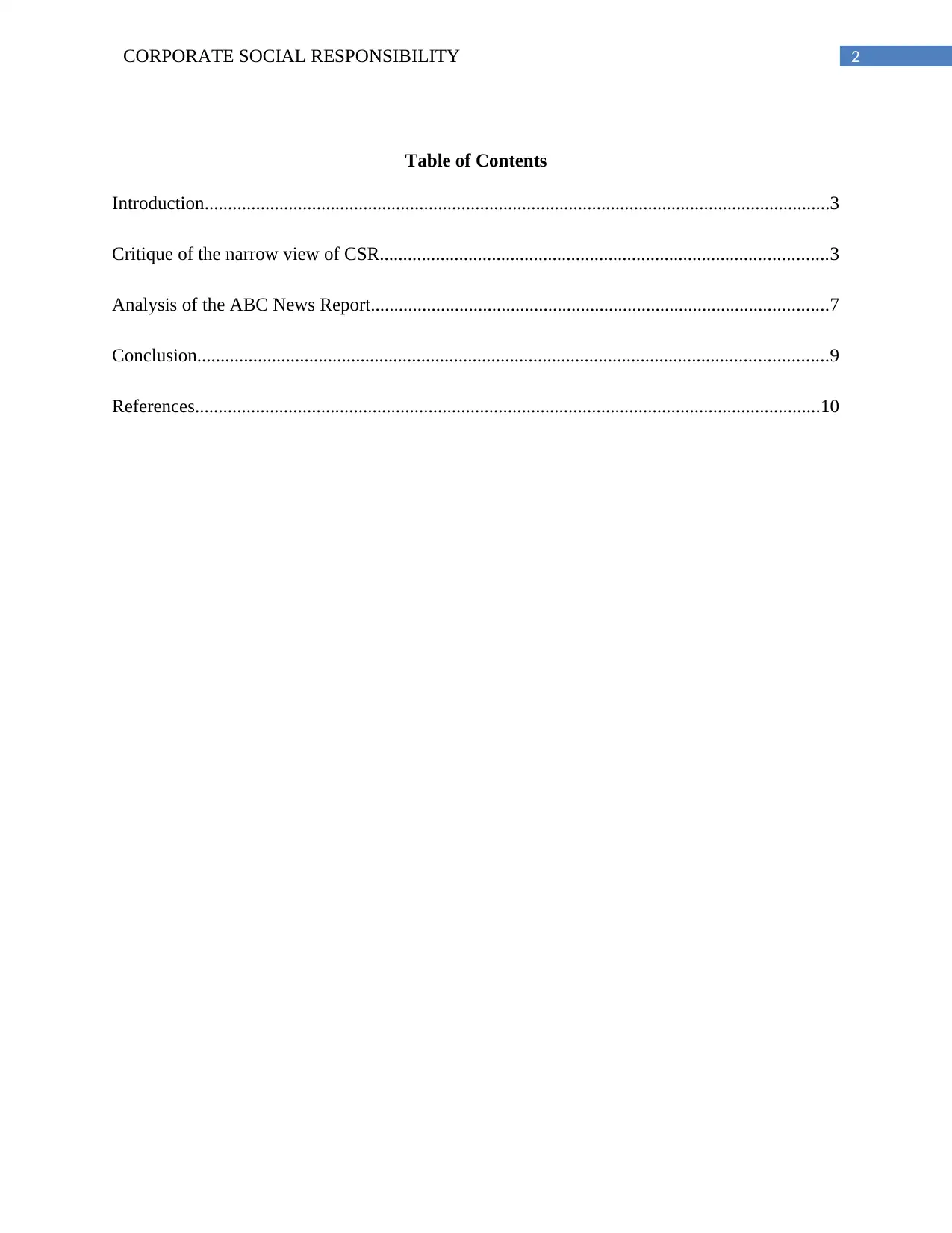
2CORPORATE SOCIAL RESPONSIBILITY
Table of Contents
Introduction......................................................................................................................................3
Critique of the narrow view of CSR................................................................................................3
Analysis of the ABC News Report..................................................................................................7
Conclusion.......................................................................................................................................9
References......................................................................................................................................10
Table of Contents
Introduction......................................................................................................................................3
Critique of the narrow view of CSR................................................................................................3
Analysis of the ABC News Report..................................................................................................7
Conclusion.......................................................................................................................................9
References......................................................................................................................................10
⊘ This is a preview!⊘
Do you want full access?
Subscribe today to unlock all pages.

Trusted by 1+ million students worldwide
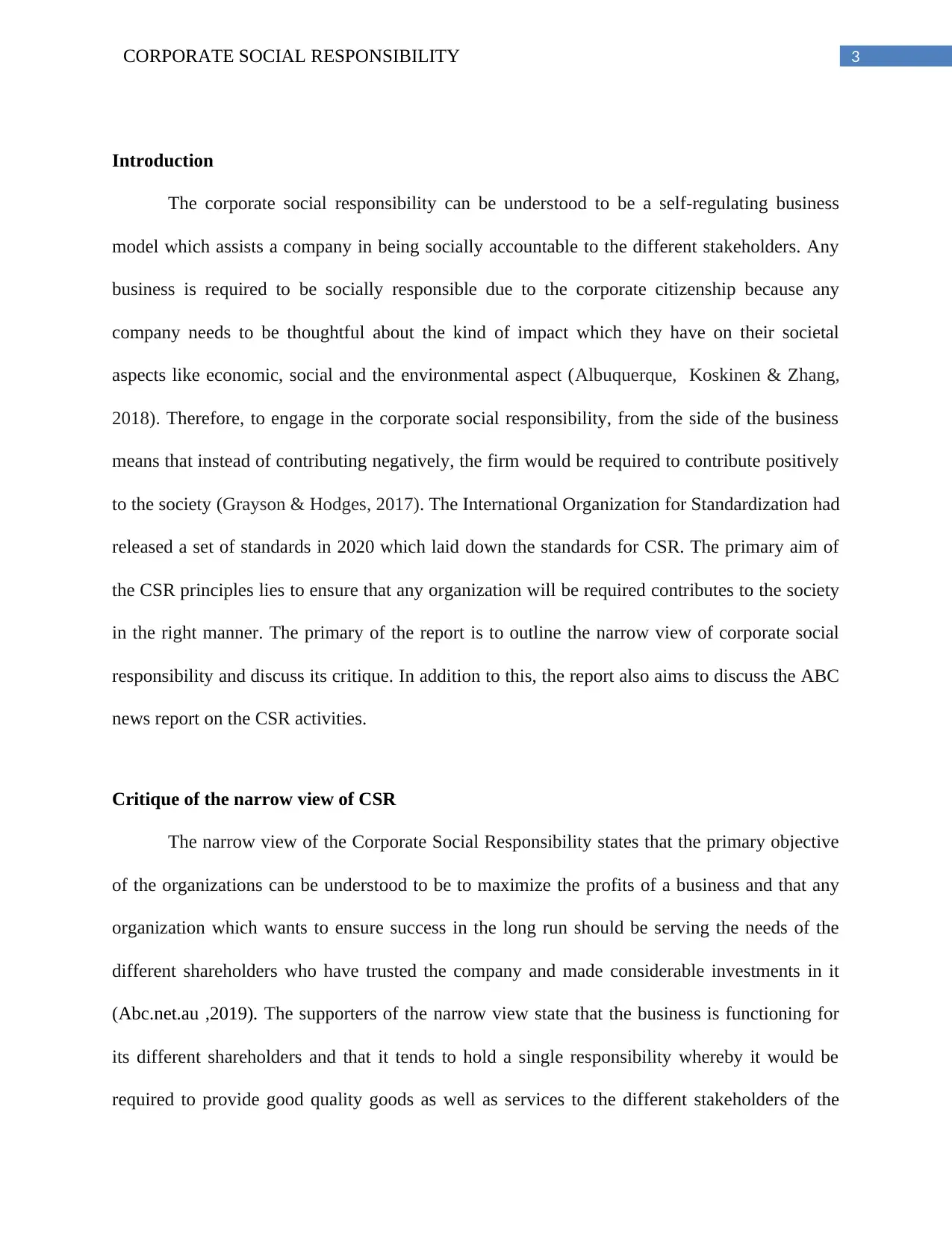
3CORPORATE SOCIAL RESPONSIBILITY
Introduction
The corporate social responsibility can be understood to be a self-regulating business
model which assists a company in being socially accountable to the different stakeholders. Any
business is required to be socially responsible due to the corporate citizenship because any
company needs to be thoughtful about the kind of impact which they have on their societal
aspects like economic, social and the environmental aspect (Albuquerque, Koskinen & Zhang,
2018). Therefore, to engage in the corporate social responsibility, from the side of the business
means that instead of contributing negatively, the firm would be required to contribute positively
to the society (Grayson & Hodges, 2017). The International Organization for Standardization had
released a set of standards in 2020 which laid down the standards for CSR. The primary aim of
the CSR principles lies to ensure that any organization will be required contributes to the society
in the right manner. The primary of the report is to outline the narrow view of corporate social
responsibility and discuss its critique. In addition to this, the report also aims to discuss the ABC
news report on the CSR activities.
Critique of the narrow view of CSR
The narrow view of the Corporate Social Responsibility states that the primary objective
of the organizations can be understood to be to maximize the profits of a business and that any
organization which wants to ensure success in the long run should be serving the needs of the
different shareholders who have trusted the company and made considerable investments in it
(Abc.net.au ,2019). The supporters of the narrow view state that the business is functioning for
its different shareholders and that it tends to hold a single responsibility whereby it would be
required to provide good quality goods as well as services to the different stakeholders of the
Introduction
The corporate social responsibility can be understood to be a self-regulating business
model which assists a company in being socially accountable to the different stakeholders. Any
business is required to be socially responsible due to the corporate citizenship because any
company needs to be thoughtful about the kind of impact which they have on their societal
aspects like economic, social and the environmental aspect (Albuquerque, Koskinen & Zhang,
2018). Therefore, to engage in the corporate social responsibility, from the side of the business
means that instead of contributing negatively, the firm would be required to contribute positively
to the society (Grayson & Hodges, 2017). The International Organization for Standardization had
released a set of standards in 2020 which laid down the standards for CSR. The primary aim of
the CSR principles lies to ensure that any organization will be required contributes to the society
in the right manner. The primary of the report is to outline the narrow view of corporate social
responsibility and discuss its critique. In addition to this, the report also aims to discuss the ABC
news report on the CSR activities.
Critique of the narrow view of CSR
The narrow view of the Corporate Social Responsibility states that the primary objective
of the organizations can be understood to be to maximize the profits of a business and that any
organization which wants to ensure success in the long run should be serving the needs of the
different shareholders who have trusted the company and made considerable investments in it
(Abc.net.au ,2019). The supporters of the narrow view state that the business is functioning for
its different shareholders and that it tends to hold a single responsibility whereby it would be
required to provide good quality goods as well as services to the different stakeholders of the
Paraphrase This Document
Need a fresh take? Get an instant paraphrase of this document with our AI Paraphraser
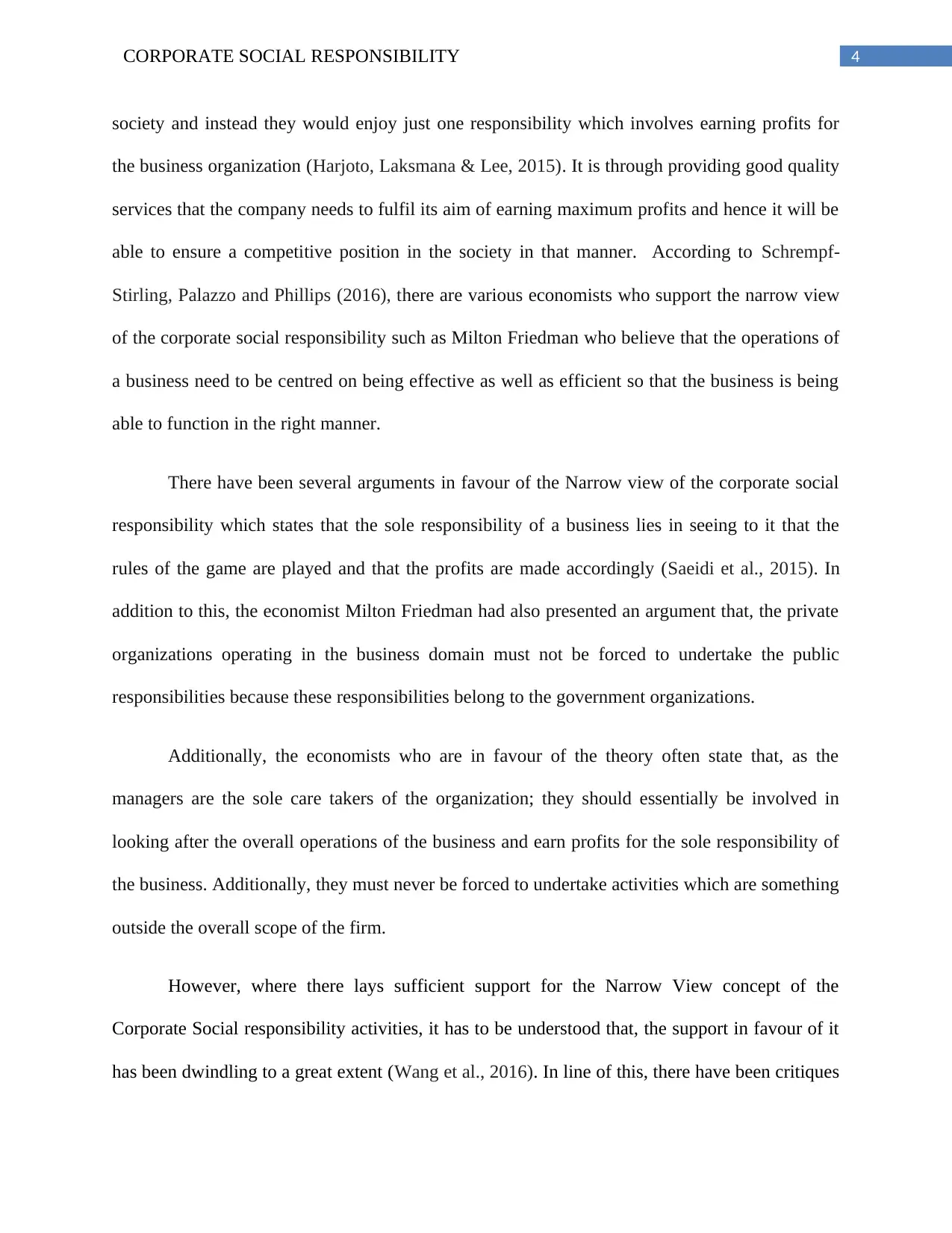
4CORPORATE SOCIAL RESPONSIBILITY
society and instead they would enjoy just one responsibility which involves earning profits for
the business organization (Harjoto, Laksmana & Lee, 2015). It is through providing good quality
services that the company needs to fulfil its aim of earning maximum profits and hence it will be
able to ensure a competitive position in the society in that manner. According to Schrempf-
Stirling, Palazzo and Phillips (2016), there are various economists who support the narrow view
of the corporate social responsibility such as Milton Friedman who believe that the operations of
a business need to be centred on being effective as well as efficient so that the business is being
able to function in the right manner.
There have been several arguments in favour of the Narrow view of the corporate social
responsibility which states that the sole responsibility of a business lies in seeing to it that the
rules of the game are played and that the profits are made accordingly (Saeidi et al., 2015). In
addition to this, the economist Milton Friedman had also presented an argument that, the private
organizations operating in the business domain must not be forced to undertake the public
responsibilities because these responsibilities belong to the government organizations.
Additionally, the economists who are in favour of the theory often state that, as the
managers are the sole care takers of the organization; they should essentially be involved in
looking after the overall operations of the business and earn profits for the sole responsibility of
the business. Additionally, they must never be forced to undertake activities which are something
outside the overall scope of the firm.
However, where there lays sufficient support for the Narrow View concept of the
Corporate Social responsibility activities, it has to be understood that, the support in favour of it
has been dwindling to a great extent (Wang et al., 2016). In line of this, there have been critiques
society and instead they would enjoy just one responsibility which involves earning profits for
the business organization (Harjoto, Laksmana & Lee, 2015). It is through providing good quality
services that the company needs to fulfil its aim of earning maximum profits and hence it will be
able to ensure a competitive position in the society in that manner. According to Schrempf-
Stirling, Palazzo and Phillips (2016), there are various economists who support the narrow view
of the corporate social responsibility such as Milton Friedman who believe that the operations of
a business need to be centred on being effective as well as efficient so that the business is being
able to function in the right manner.
There have been several arguments in favour of the Narrow view of the corporate social
responsibility which states that the sole responsibility of a business lies in seeing to it that the
rules of the game are played and that the profits are made accordingly (Saeidi et al., 2015). In
addition to this, the economist Milton Friedman had also presented an argument that, the private
organizations operating in the business domain must not be forced to undertake the public
responsibilities because these responsibilities belong to the government organizations.
Additionally, the economists who are in favour of the theory often state that, as the
managers are the sole care takers of the organization; they should essentially be involved in
looking after the overall operations of the business and earn profits for the sole responsibility of
the business. Additionally, they must never be forced to undertake activities which are something
outside the overall scope of the firm.
However, where there lays sufficient support for the Narrow View concept of the
Corporate Social responsibility activities, it has to be understood that, the support in favour of it
has been dwindling to a great extent (Wang et al., 2016). In line of this, there have been critiques
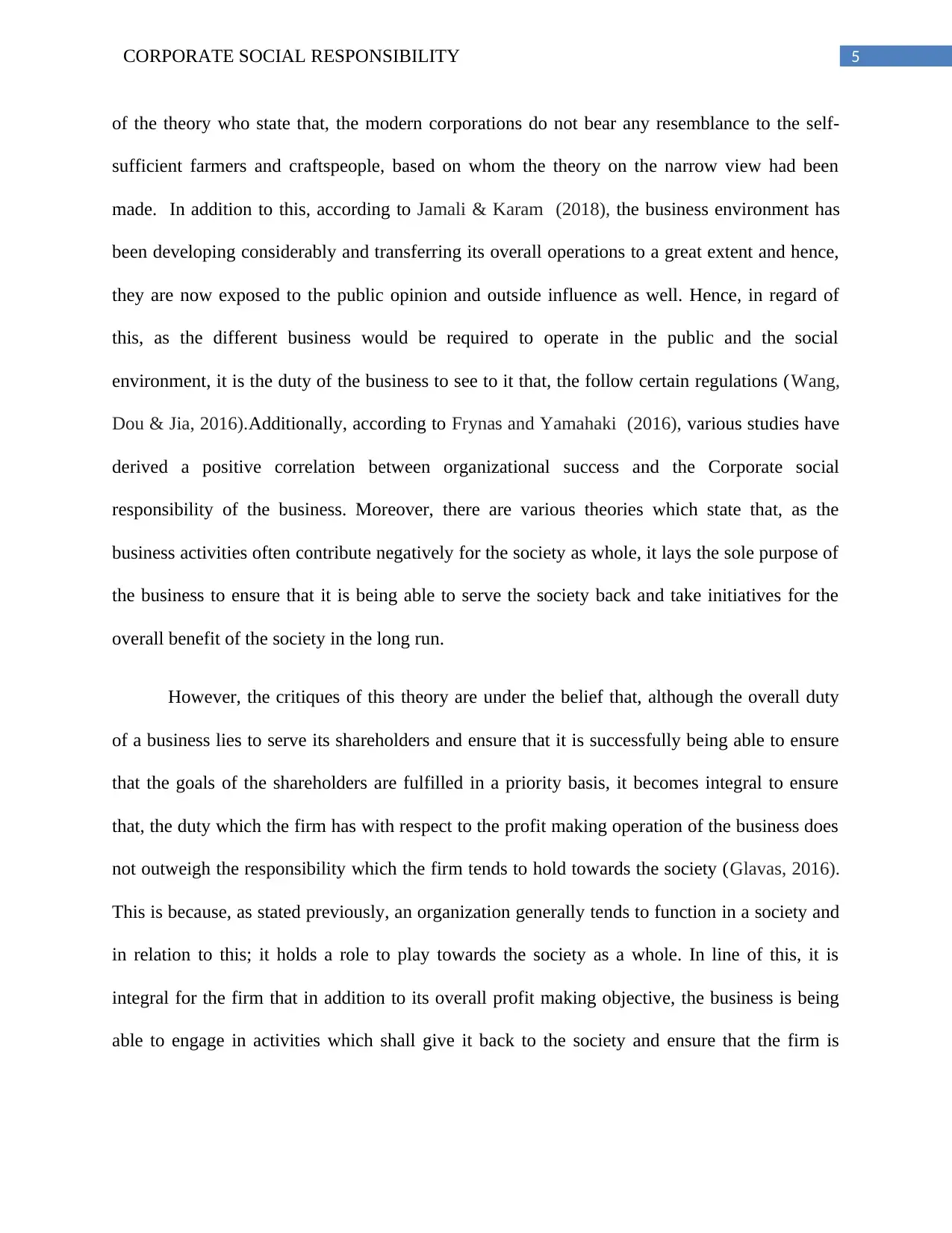
5CORPORATE SOCIAL RESPONSIBILITY
of the theory who state that, the modern corporations do not bear any resemblance to the self-
sufficient farmers and craftspeople, based on whom the theory on the narrow view had been
made. In addition to this, according to Jamali & Karam (2018), the business environment has
been developing considerably and transferring its overall operations to a great extent and hence,
they are now exposed to the public opinion and outside influence as well. Hence, in regard of
this, as the different business would be required to operate in the public and the social
environment, it is the duty of the business to see to it that, the follow certain regulations (Wang,
Dou & Jia, 2016).Additionally, according to Frynas and Yamahaki (2016), various studies have
derived a positive correlation between organizational success and the Corporate social
responsibility of the business. Moreover, there are various theories which state that, as the
business activities often contribute negatively for the society as whole, it lays the sole purpose of
the business to ensure that it is being able to serve the society back and take initiatives for the
overall benefit of the society in the long run.
However, the critiques of this theory are under the belief that, although the overall duty
of a business lies to serve its shareholders and ensure that it is successfully being able to ensure
that the goals of the shareholders are fulfilled in a priority basis, it becomes integral to ensure
that, the duty which the firm has with respect to the profit making operation of the business does
not outweigh the responsibility which the firm tends to hold towards the society (Glavas, 2016).
This is because, as stated previously, an organization generally tends to function in a society and
in relation to this; it holds a role to play towards the society as a whole. In line of this, it is
integral for the firm that in addition to its overall profit making objective, the business is being
able to engage in activities which shall give it back to the society and ensure that the firm is
of the theory who state that, the modern corporations do not bear any resemblance to the self-
sufficient farmers and craftspeople, based on whom the theory on the narrow view had been
made. In addition to this, according to Jamali & Karam (2018), the business environment has
been developing considerably and transferring its overall operations to a great extent and hence,
they are now exposed to the public opinion and outside influence as well. Hence, in regard of
this, as the different business would be required to operate in the public and the social
environment, it is the duty of the business to see to it that, the follow certain regulations (Wang,
Dou & Jia, 2016).Additionally, according to Frynas and Yamahaki (2016), various studies have
derived a positive correlation between organizational success and the Corporate social
responsibility of the business. Moreover, there are various theories which state that, as the
business activities often contribute negatively for the society as whole, it lays the sole purpose of
the business to ensure that it is being able to serve the society back and take initiatives for the
overall benefit of the society in the long run.
However, the critiques of this theory are under the belief that, although the overall duty
of a business lies to serve its shareholders and ensure that it is successfully being able to ensure
that the goals of the shareholders are fulfilled in a priority basis, it becomes integral to ensure
that, the duty which the firm has with respect to the profit making operation of the business does
not outweigh the responsibility which the firm tends to hold towards the society (Glavas, 2016).
This is because, as stated previously, an organization generally tends to function in a society and
in relation to this; it holds a role to play towards the society as a whole. In line of this, it is
integral for the firm that in addition to its overall profit making objective, the business is being
able to engage in activities which shall give it back to the society and ensure that the firm is
⊘ This is a preview!⊘
Do you want full access?
Subscribe today to unlock all pages.

Trusted by 1+ million students worldwide
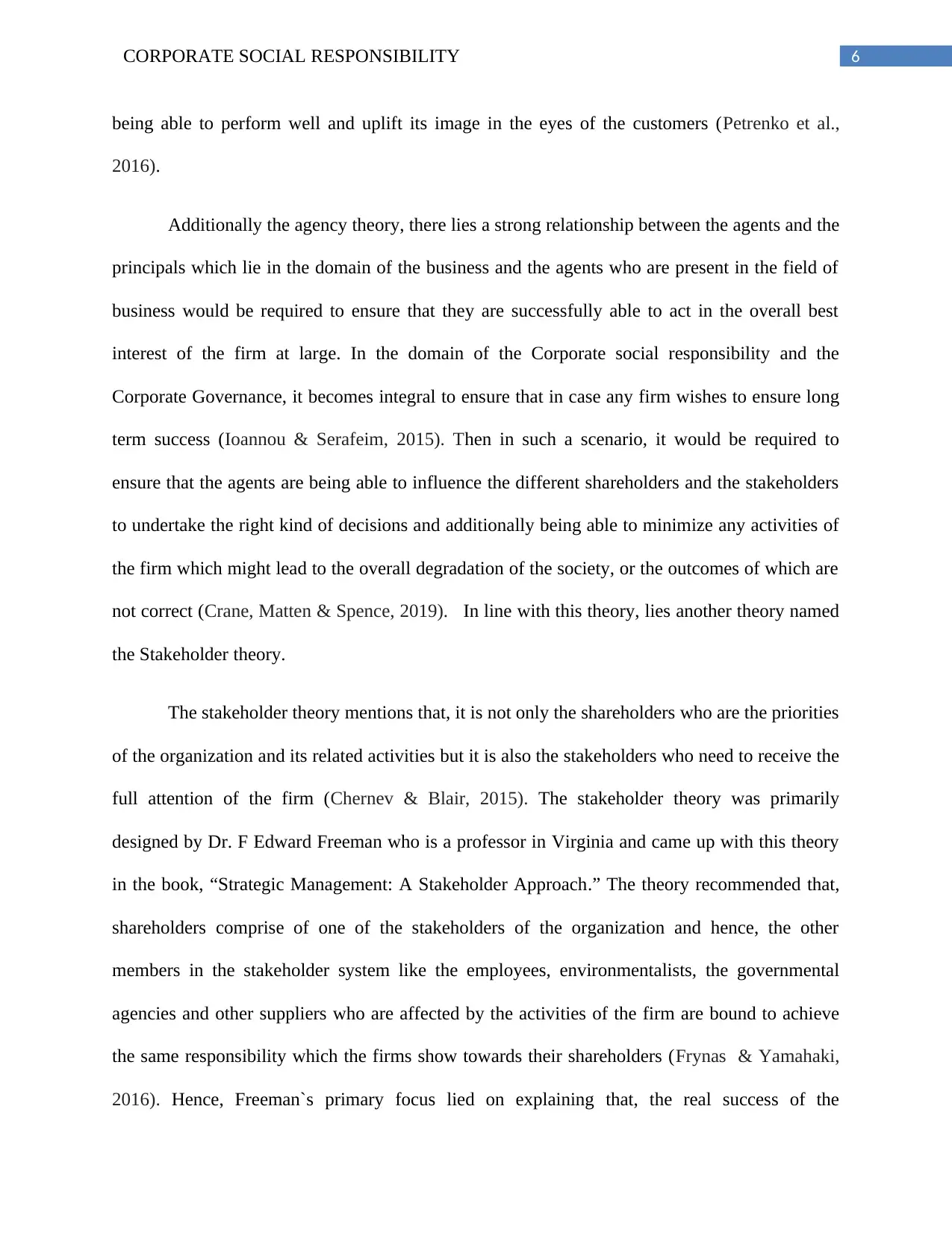
6CORPORATE SOCIAL RESPONSIBILITY
being able to perform well and uplift its image in the eyes of the customers (Petrenko et al.,
2016).
Additionally the agency theory, there lies a strong relationship between the agents and the
principals which lie in the domain of the business and the agents who are present in the field of
business would be required to ensure that they are successfully able to act in the overall best
interest of the firm at large. In the domain of the Corporate social responsibility and the
Corporate Governance, it becomes integral to ensure that in case any firm wishes to ensure long
term success (Ioannou & Serafeim, 2015). Then in such a scenario, it would be required to
ensure that the agents are being able to influence the different shareholders and the stakeholders
to undertake the right kind of decisions and additionally being able to minimize any activities of
the firm which might lead to the overall degradation of the society, or the outcomes of which are
not correct (Crane, Matten & Spence, 2019). In line with this theory, lies another theory named
the Stakeholder theory.
The stakeholder theory mentions that, it is not only the shareholders who are the priorities
of the organization and its related activities but it is also the stakeholders who need to receive the
full attention of the firm (Chernev & Blair, 2015). The stakeholder theory was primarily
designed by Dr. F Edward Freeman who is a professor in Virginia and came up with this theory
in the book, “Strategic Management: A Stakeholder Approach.” The theory recommended that,
shareholders comprise of one of the stakeholders of the organization and hence, the other
members in the stakeholder system like the employees, environmentalists, the governmental
agencies and other suppliers who are affected by the activities of the firm are bound to achieve
the same responsibility which the firms show towards their shareholders (Frynas & Yamahaki,
2016). Hence, Freeman`s primary focus lied on explaining that, the real success of the
being able to perform well and uplift its image in the eyes of the customers (Petrenko et al.,
2016).
Additionally the agency theory, there lies a strong relationship between the agents and the
principals which lie in the domain of the business and the agents who are present in the field of
business would be required to ensure that they are successfully able to act in the overall best
interest of the firm at large. In the domain of the Corporate social responsibility and the
Corporate Governance, it becomes integral to ensure that in case any firm wishes to ensure long
term success (Ioannou & Serafeim, 2015). Then in such a scenario, it would be required to
ensure that the agents are being able to influence the different shareholders and the stakeholders
to undertake the right kind of decisions and additionally being able to minimize any activities of
the firm which might lead to the overall degradation of the society, or the outcomes of which are
not correct (Crane, Matten & Spence, 2019). In line with this theory, lies another theory named
the Stakeholder theory.
The stakeholder theory mentions that, it is not only the shareholders who are the priorities
of the organization and its related activities but it is also the stakeholders who need to receive the
full attention of the firm (Chernev & Blair, 2015). The stakeholder theory was primarily
designed by Dr. F Edward Freeman who is a professor in Virginia and came up with this theory
in the book, “Strategic Management: A Stakeholder Approach.” The theory recommended that,
shareholders comprise of one of the stakeholders of the organization and hence, the other
members in the stakeholder system like the employees, environmentalists, the governmental
agencies and other suppliers who are affected by the activities of the firm are bound to achieve
the same responsibility which the firms show towards their shareholders (Frynas & Yamahaki,
2016). Hence, Freeman`s primary focus lied on explaining that, the real success of the
Paraphrase This Document
Need a fresh take? Get an instant paraphrase of this document with our AI Paraphraser
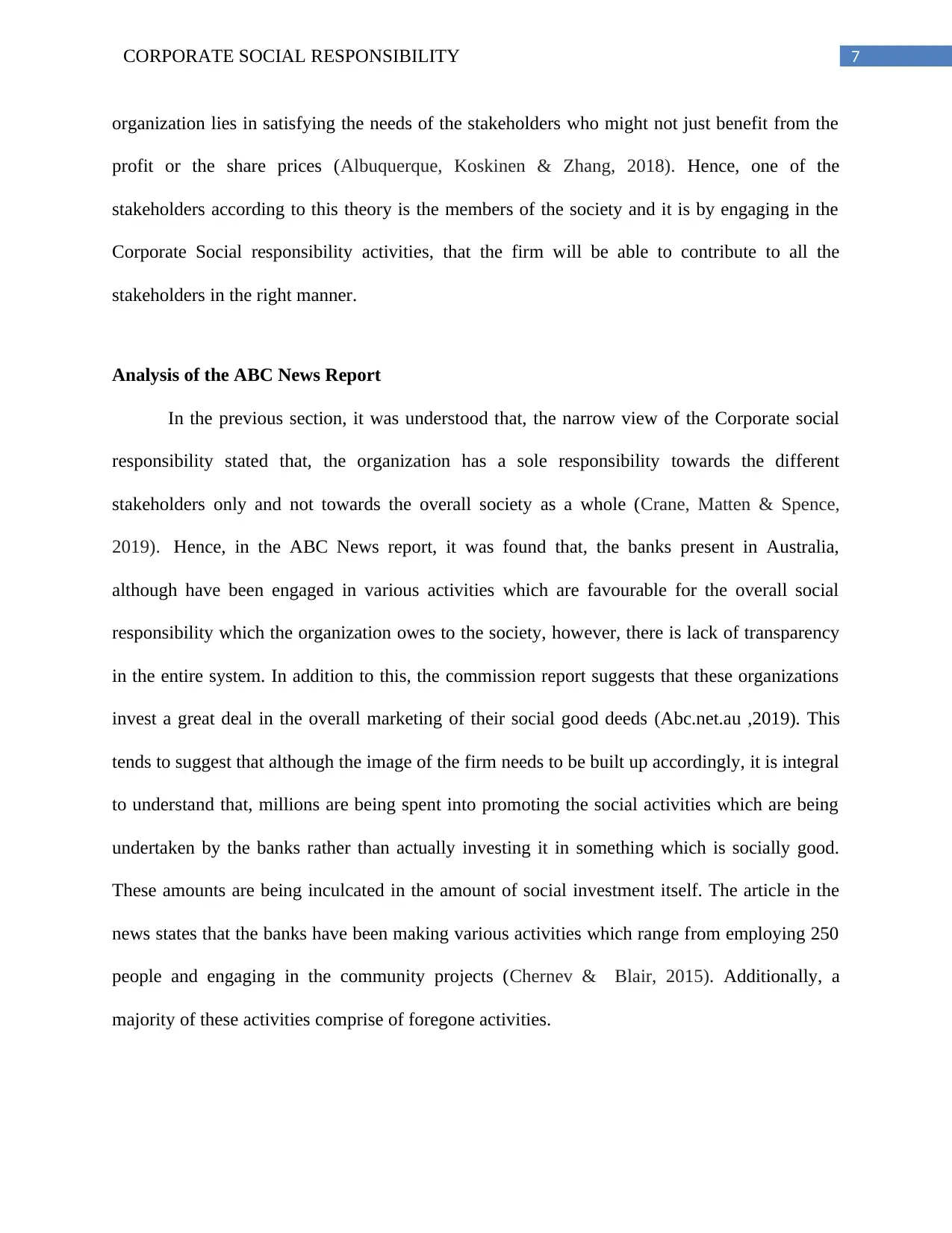
7CORPORATE SOCIAL RESPONSIBILITY
organization lies in satisfying the needs of the stakeholders who might not just benefit from the
profit or the share prices (Albuquerque, Koskinen & Zhang, 2018). Hence, one of the
stakeholders according to this theory is the members of the society and it is by engaging in the
Corporate Social responsibility activities, that the firm will be able to contribute to all the
stakeholders in the right manner.
Analysis of the ABC News Report
In the previous section, it was understood that, the narrow view of the Corporate social
responsibility stated that, the organization has a sole responsibility towards the different
stakeholders only and not towards the overall society as a whole (Crane, Matten & Spence,
2019). Hence, in the ABC News report, it was found that, the banks present in Australia,
although have been engaged in various activities which are favourable for the overall social
responsibility which the organization owes to the society, however, there is lack of transparency
in the entire system. In addition to this, the commission report suggests that these organizations
invest a great deal in the overall marketing of their social good deeds (Abc.net.au ,2019). This
tends to suggest that although the image of the firm needs to be built up accordingly, it is integral
to understand that, millions are being spent into promoting the social activities which are being
undertaken by the banks rather than actually investing it in something which is socially good.
These amounts are being inculcated in the amount of social investment itself. The article in the
news states that the banks have been making various activities which range from employing 250
people and engaging in the community projects (Chernev & Blair, 2015). Additionally, a
majority of these activities comprise of foregone activities.
organization lies in satisfying the needs of the stakeholders who might not just benefit from the
profit or the share prices (Albuquerque, Koskinen & Zhang, 2018). Hence, one of the
stakeholders according to this theory is the members of the society and it is by engaging in the
Corporate Social responsibility activities, that the firm will be able to contribute to all the
stakeholders in the right manner.
Analysis of the ABC News Report
In the previous section, it was understood that, the narrow view of the Corporate social
responsibility stated that, the organization has a sole responsibility towards the different
stakeholders only and not towards the overall society as a whole (Crane, Matten & Spence,
2019). Hence, in the ABC News report, it was found that, the banks present in Australia,
although have been engaged in various activities which are favourable for the overall social
responsibility which the organization owes to the society, however, there is lack of transparency
in the entire system. In addition to this, the commission report suggests that these organizations
invest a great deal in the overall marketing of their social good deeds (Abc.net.au ,2019). This
tends to suggest that although the image of the firm needs to be built up accordingly, it is integral
to understand that, millions are being spent into promoting the social activities which are being
undertaken by the banks rather than actually investing it in something which is socially good.
These amounts are being inculcated in the amount of social investment itself. The article in the
news states that the banks have been making various activities which range from employing 250
people and engaging in the community projects (Chernev & Blair, 2015). Additionally, a
majority of these activities comprise of foregone activities.
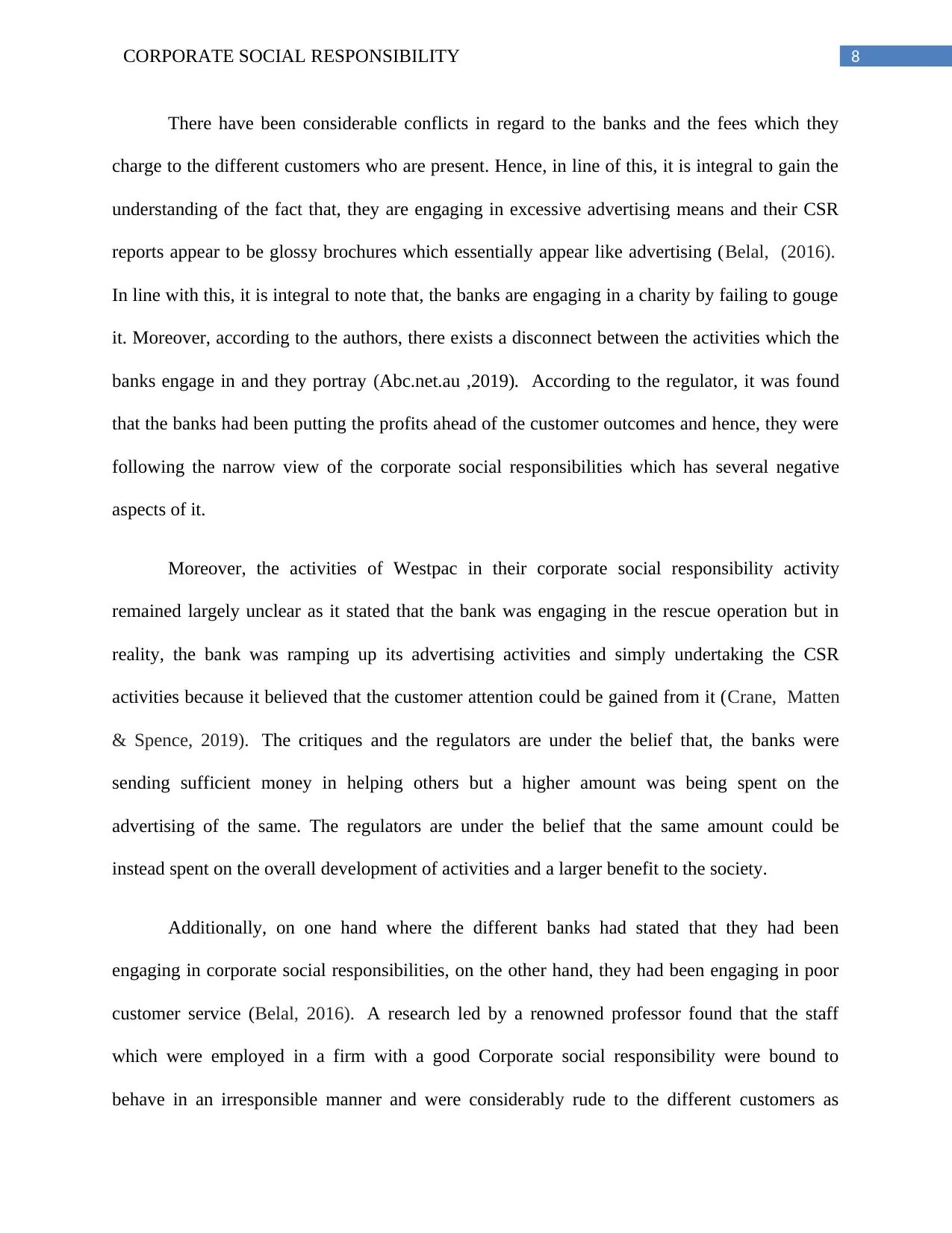
8CORPORATE SOCIAL RESPONSIBILITY
There have been considerable conflicts in regard to the banks and the fees which they
charge to the different customers who are present. Hence, in line of this, it is integral to gain the
understanding of the fact that, they are engaging in excessive advertising means and their CSR
reports appear to be glossy brochures which essentially appear like advertising (Belal, (2016).
In line with this, it is integral to note that, the banks are engaging in a charity by failing to gouge
it. Moreover, according to the authors, there exists a disconnect between the activities which the
banks engage in and they portray (Abc.net.au ,2019). According to the regulator, it was found
that the banks had been putting the profits ahead of the customer outcomes and hence, they were
following the narrow view of the corporate social responsibilities which has several negative
aspects of it.
Moreover, the activities of Westpac in their corporate social responsibility activity
remained largely unclear as it stated that the bank was engaging in the rescue operation but in
reality, the bank was ramping up its advertising activities and simply undertaking the CSR
activities because it believed that the customer attention could be gained from it (Crane, Matten
& Spence, 2019). The critiques and the regulators are under the belief that, the banks were
sending sufficient money in helping others but a higher amount was being spent on the
advertising of the same. The regulators are under the belief that the same amount could be
instead spent on the overall development of activities and a larger benefit to the society.
Additionally, on one hand where the different banks had stated that they had been
engaging in corporate social responsibilities, on the other hand, they had been engaging in poor
customer service (Belal, 2016). A research led by a renowned professor found that the staff
which were employed in a firm with a good Corporate social responsibility were bound to
behave in an irresponsible manner and were considerably rude to the different customers as
There have been considerable conflicts in regard to the banks and the fees which they
charge to the different customers who are present. Hence, in line of this, it is integral to gain the
understanding of the fact that, they are engaging in excessive advertising means and their CSR
reports appear to be glossy brochures which essentially appear like advertising (Belal, (2016).
In line with this, it is integral to note that, the banks are engaging in a charity by failing to gouge
it. Moreover, according to the authors, there exists a disconnect between the activities which the
banks engage in and they portray (Abc.net.au ,2019). According to the regulator, it was found
that the banks had been putting the profits ahead of the customer outcomes and hence, they were
following the narrow view of the corporate social responsibilities which has several negative
aspects of it.
Moreover, the activities of Westpac in their corporate social responsibility activity
remained largely unclear as it stated that the bank was engaging in the rescue operation but in
reality, the bank was ramping up its advertising activities and simply undertaking the CSR
activities because it believed that the customer attention could be gained from it (Crane, Matten
& Spence, 2019). The critiques and the regulators are under the belief that, the banks were
sending sufficient money in helping others but a higher amount was being spent on the
advertising of the same. The regulators are under the belief that the same amount could be
instead spent on the overall development of activities and a larger benefit to the society.
Additionally, on one hand where the different banks had stated that they had been
engaging in corporate social responsibilities, on the other hand, they had been engaging in poor
customer service (Belal, 2016). A research led by a renowned professor found that the staff
which were employed in a firm with a good Corporate social responsibility were bound to
behave in an irresponsible manner and were considerably rude to the different customers as
⊘ This is a preview!⊘
Do you want full access?
Subscribe today to unlock all pages.

Trusted by 1+ million students worldwide
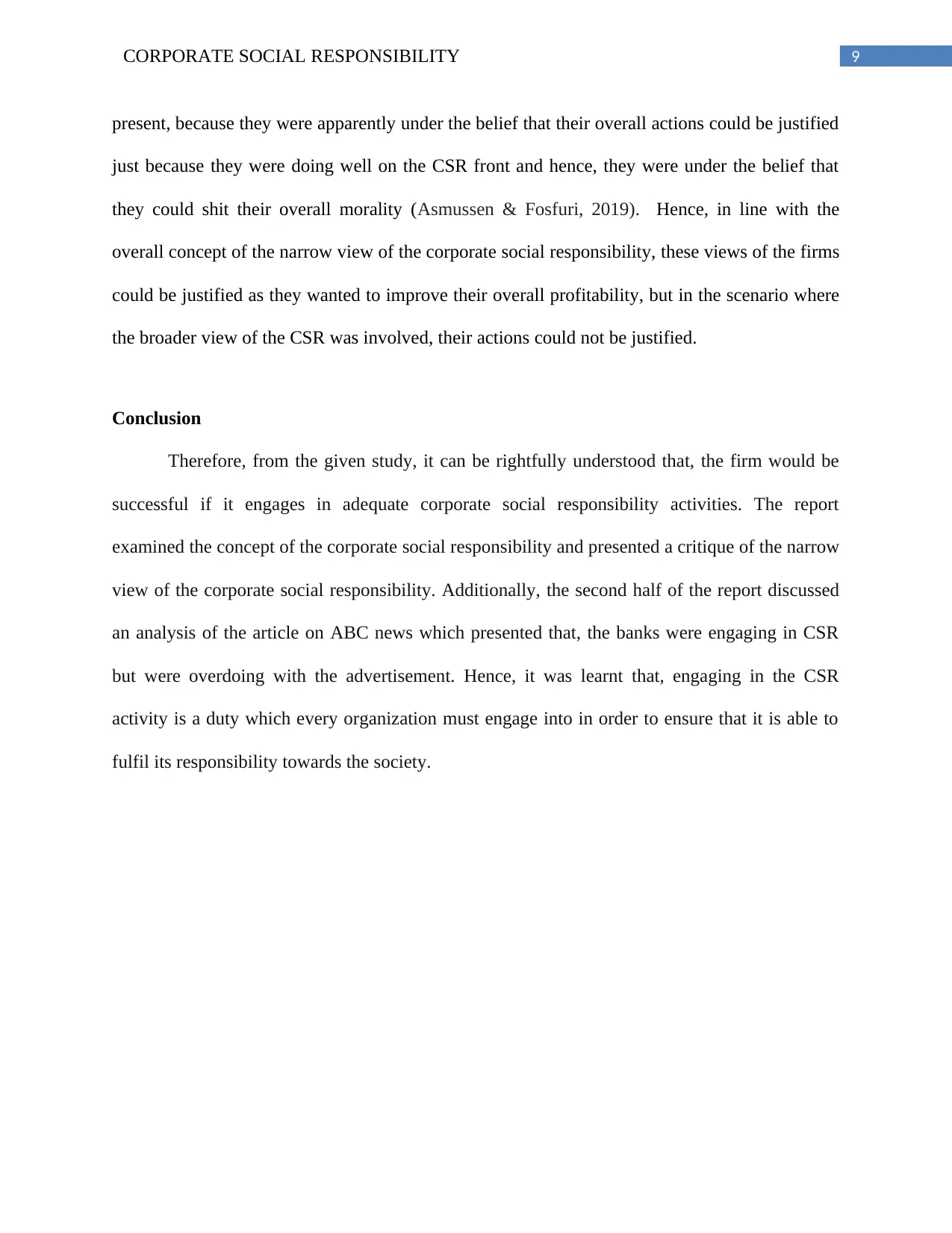
9CORPORATE SOCIAL RESPONSIBILITY
present, because they were apparently under the belief that their overall actions could be justified
just because they were doing well on the CSR front and hence, they were under the belief that
they could shit their overall morality (Asmussen & Fosfuri, 2019). Hence, in line with the
overall concept of the narrow view of the corporate social responsibility, these views of the firms
could be justified as they wanted to improve their overall profitability, but in the scenario where
the broader view of the CSR was involved, their actions could not be justified.
Conclusion
Therefore, from the given study, it can be rightfully understood that, the firm would be
successful if it engages in adequate corporate social responsibility activities. The report
examined the concept of the corporate social responsibility and presented a critique of the narrow
view of the corporate social responsibility. Additionally, the second half of the report discussed
an analysis of the article on ABC news which presented that, the banks were engaging in CSR
but were overdoing with the advertisement. Hence, it was learnt that, engaging in the CSR
activity is a duty which every organization must engage into in order to ensure that it is able to
fulfil its responsibility towards the society.
present, because they were apparently under the belief that their overall actions could be justified
just because they were doing well on the CSR front and hence, they were under the belief that
they could shit their overall morality (Asmussen & Fosfuri, 2019). Hence, in line with the
overall concept of the narrow view of the corporate social responsibility, these views of the firms
could be justified as they wanted to improve their overall profitability, but in the scenario where
the broader view of the CSR was involved, their actions could not be justified.
Conclusion
Therefore, from the given study, it can be rightfully understood that, the firm would be
successful if it engages in adequate corporate social responsibility activities. The report
examined the concept of the corporate social responsibility and presented a critique of the narrow
view of the corporate social responsibility. Additionally, the second half of the report discussed
an analysis of the article on ABC news which presented that, the banks were engaging in CSR
but were overdoing with the advertisement. Hence, it was learnt that, engaging in the CSR
activity is a duty which every organization must engage into in order to ensure that it is able to
fulfil its responsibility towards the society.
Paraphrase This Document
Need a fresh take? Get an instant paraphrase of this document with our AI Paraphraser
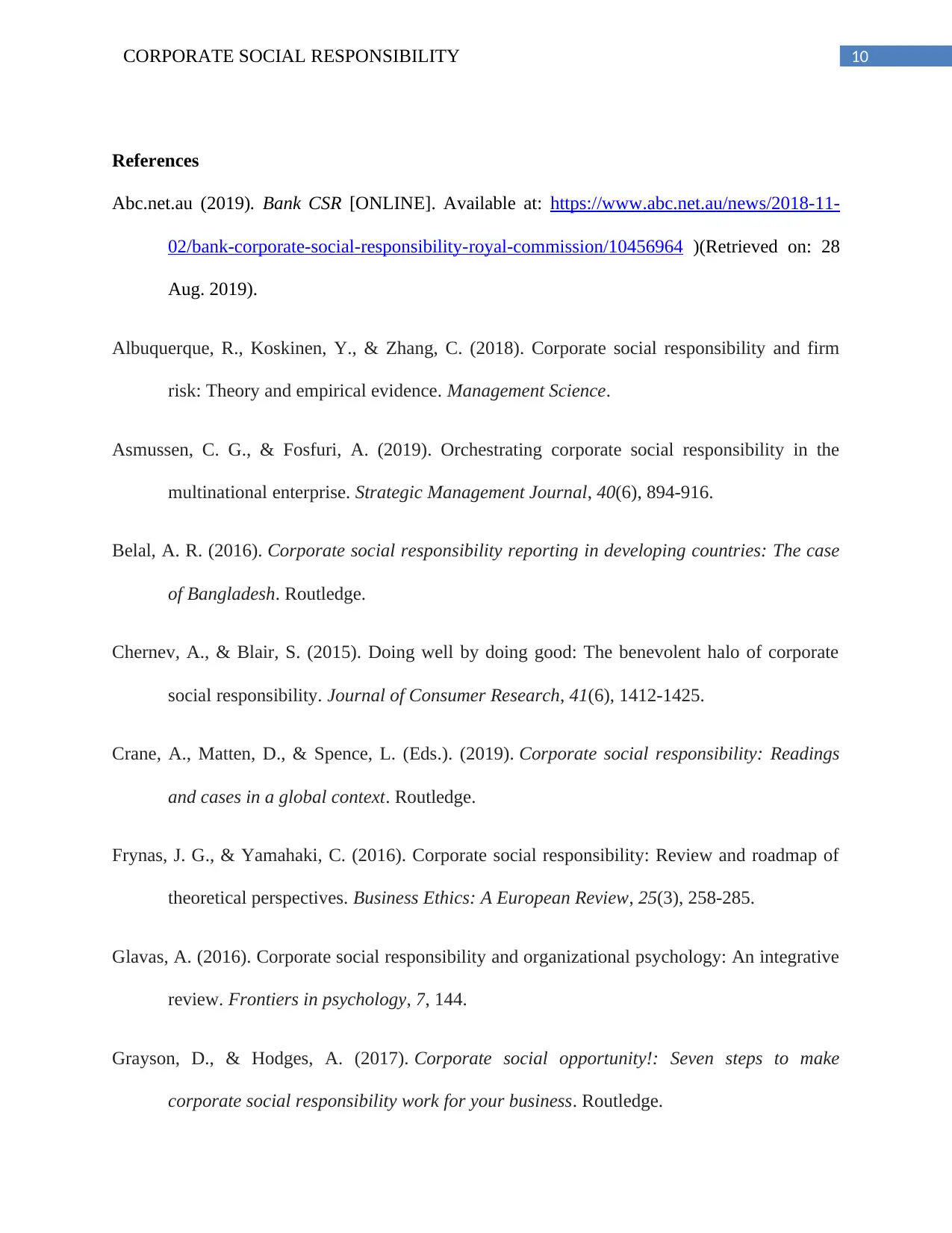
10CORPORATE SOCIAL RESPONSIBILITY
References
Abc.net.au (2019). Bank CSR [ONLINE]. Available at: https://www.abc.net.au/news/2018-11-
02/bank-corporate-social-responsibility-royal-commission/10456964 )(Retrieved on: 28
Aug. 2019).
Albuquerque, R., Koskinen, Y., & Zhang, C. (2018). Corporate social responsibility and firm
risk: Theory and empirical evidence. Management Science.
Asmussen, C. G., & Fosfuri, A. (2019). Orchestrating corporate social responsibility in the
multinational enterprise. Strategic Management Journal, 40(6), 894-916.
Belal, A. R. (2016). Corporate social responsibility reporting in developing countries: The case
of Bangladesh. Routledge.
Chernev, A., & Blair, S. (2015). Doing well by doing good: The benevolent halo of corporate
social responsibility. Journal of Consumer Research, 41(6), 1412-1425.
Crane, A., Matten, D., & Spence, L. (Eds.). (2019). Corporate social responsibility: Readings
and cases in a global context. Routledge.
Frynas, J. G., & Yamahaki, C. (2016). Corporate social responsibility: Review and roadmap of
theoretical perspectives. Business Ethics: A European Review, 25(3), 258-285.
Glavas, A. (2016). Corporate social responsibility and organizational psychology: An integrative
review. Frontiers in psychology, 7, 144.
Grayson, D., & Hodges, A. (2017). Corporate social opportunity!: Seven steps to make
corporate social responsibility work for your business. Routledge.
References
Abc.net.au (2019). Bank CSR [ONLINE]. Available at: https://www.abc.net.au/news/2018-11-
02/bank-corporate-social-responsibility-royal-commission/10456964 )(Retrieved on: 28
Aug. 2019).
Albuquerque, R., Koskinen, Y., & Zhang, C. (2018). Corporate social responsibility and firm
risk: Theory and empirical evidence. Management Science.
Asmussen, C. G., & Fosfuri, A. (2019). Orchestrating corporate social responsibility in the
multinational enterprise. Strategic Management Journal, 40(6), 894-916.
Belal, A. R. (2016). Corporate social responsibility reporting in developing countries: The case
of Bangladesh. Routledge.
Chernev, A., & Blair, S. (2015). Doing well by doing good: The benevolent halo of corporate
social responsibility. Journal of Consumer Research, 41(6), 1412-1425.
Crane, A., Matten, D., & Spence, L. (Eds.). (2019). Corporate social responsibility: Readings
and cases in a global context. Routledge.
Frynas, J. G., & Yamahaki, C. (2016). Corporate social responsibility: Review and roadmap of
theoretical perspectives. Business Ethics: A European Review, 25(3), 258-285.
Glavas, A. (2016). Corporate social responsibility and organizational psychology: An integrative
review. Frontiers in psychology, 7, 144.
Grayson, D., & Hodges, A. (2017). Corporate social opportunity!: Seven steps to make
corporate social responsibility work for your business. Routledge.
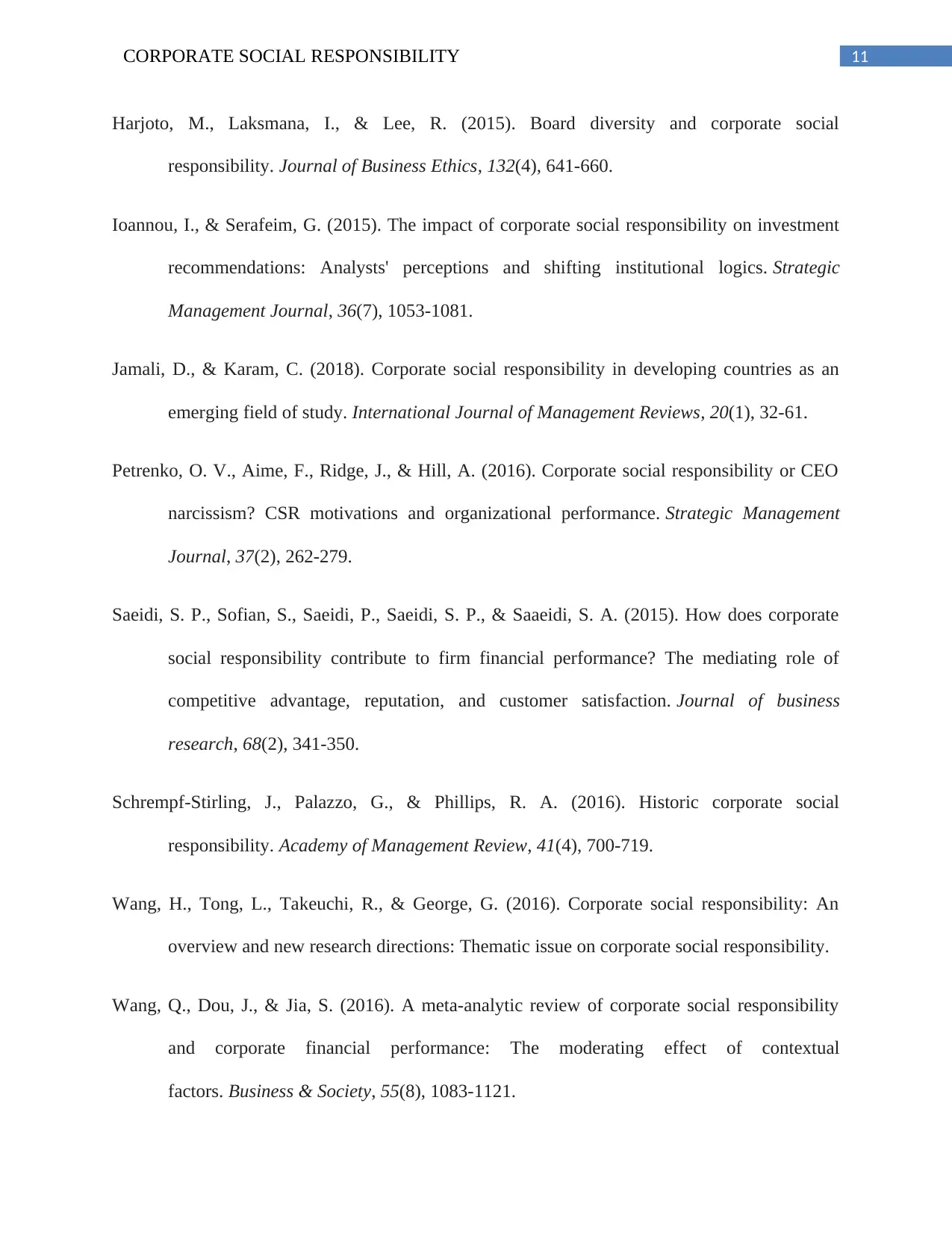
11CORPORATE SOCIAL RESPONSIBILITY
Harjoto, M., Laksmana, I., & Lee, R. (2015). Board diversity and corporate social
responsibility. Journal of Business Ethics, 132(4), 641-660.
Ioannou, I., & Serafeim, G. (2015). The impact of corporate social responsibility on investment
recommendations: Analysts' perceptions and shifting institutional logics. Strategic
Management Journal, 36(7), 1053-1081.
Jamali, D., & Karam, C. (2018). Corporate social responsibility in developing countries as an
emerging field of study. International Journal of Management Reviews, 20(1), 32-61.
Petrenko, O. V., Aime, F., Ridge, J., & Hill, A. (2016). Corporate social responsibility or CEO
narcissism? CSR motivations and organizational performance. Strategic Management
Journal, 37(2), 262-279.
Saeidi, S. P., Sofian, S., Saeidi, P., Saeidi, S. P., & Saaeidi, S. A. (2015). How does corporate
social responsibility contribute to firm financial performance? The mediating role of
competitive advantage, reputation, and customer satisfaction. Journal of business
research, 68(2), 341-350.
Schrempf-Stirling, J., Palazzo, G., & Phillips, R. A. (2016). Historic corporate social
responsibility. Academy of Management Review, 41(4), 700-719.
Wang, H., Tong, L., Takeuchi, R., & George, G. (2016). Corporate social responsibility: An
overview and new research directions: Thematic issue on corporate social responsibility.
Wang, Q., Dou, J., & Jia, S. (2016). A meta-analytic review of corporate social responsibility
and corporate financial performance: The moderating effect of contextual
factors. Business & Society, 55(8), 1083-1121.
Harjoto, M., Laksmana, I., & Lee, R. (2015). Board diversity and corporate social
responsibility. Journal of Business Ethics, 132(4), 641-660.
Ioannou, I., & Serafeim, G. (2015). The impact of corporate social responsibility on investment
recommendations: Analysts' perceptions and shifting institutional logics. Strategic
Management Journal, 36(7), 1053-1081.
Jamali, D., & Karam, C. (2018). Corporate social responsibility in developing countries as an
emerging field of study. International Journal of Management Reviews, 20(1), 32-61.
Petrenko, O. V., Aime, F., Ridge, J., & Hill, A. (2016). Corporate social responsibility or CEO
narcissism? CSR motivations and organizational performance. Strategic Management
Journal, 37(2), 262-279.
Saeidi, S. P., Sofian, S., Saeidi, P., Saeidi, S. P., & Saaeidi, S. A. (2015). How does corporate
social responsibility contribute to firm financial performance? The mediating role of
competitive advantage, reputation, and customer satisfaction. Journal of business
research, 68(2), 341-350.
Schrempf-Stirling, J., Palazzo, G., & Phillips, R. A. (2016). Historic corporate social
responsibility. Academy of Management Review, 41(4), 700-719.
Wang, H., Tong, L., Takeuchi, R., & George, G. (2016). Corporate social responsibility: An
overview and new research directions: Thematic issue on corporate social responsibility.
Wang, Q., Dou, J., & Jia, S. (2016). A meta-analytic review of corporate social responsibility
and corporate financial performance: The moderating effect of contextual
factors. Business & Society, 55(8), 1083-1121.
⊘ This is a preview!⊘
Do you want full access?
Subscribe today to unlock all pages.

Trusted by 1+ million students worldwide
1 out of 12
Related Documents
Your All-in-One AI-Powered Toolkit for Academic Success.
+13062052269
info@desklib.com
Available 24*7 on WhatsApp / Email
![[object Object]](/_next/static/media/star-bottom.7253800d.svg)
Unlock your academic potential
Copyright © 2020–2025 A2Z Services. All Rights Reserved. Developed and managed by ZUCOL.



